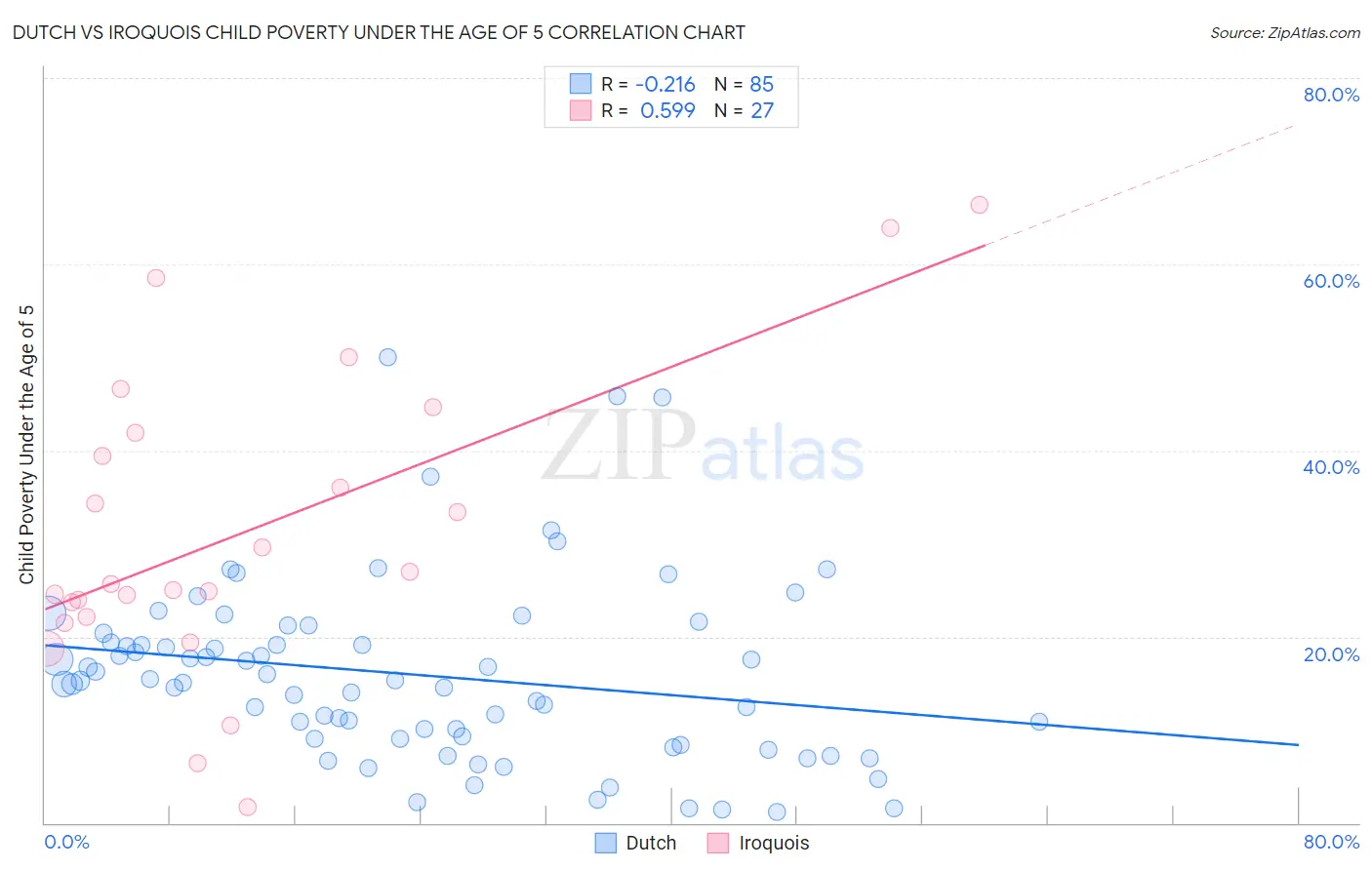Dutch vs Iroquois Child Poverty Under the Age of 5
COMPARE
Dutch
Iroquois
Child Poverty Under the Age of 5
Child Poverty Under the Age of 5 Comparison
Dutch
Iroquois
16.7%
CHILD POVERTY UNDER THE AGE OF 5
77.1/ 100
METRIC RATING
153rd/ 347
METRIC RANK
22.0%
CHILD POVERTY UNDER THE AGE OF 5
0.0/ 100
METRIC RATING
302nd/ 347
METRIC RANK
Dutch vs Iroquois Child Poverty Under the Age of 5 Correlation Chart
The statistical analysis conducted on geographies consisting of 516,653,968 people shows a weak negative correlation between the proportion of Dutch and poverty level among children under the age of 5 in the United States with a correlation coefficient (R) of -0.216 and weighted average of 16.7%. Similarly, the statistical analysis conducted on geographies consisting of 202,992,045 people shows a substantial positive correlation between the proportion of Iroquois and poverty level among children under the age of 5 in the United States with a correlation coefficient (R) of 0.599 and weighted average of 22.0%, a difference of 31.8%.

Child Poverty Under the Age of 5 Correlation Summary
| Measurement | Dutch | Iroquois |
| Minimum | 1.2% | 1.6% |
| Maximum | 50.0% | 66.3% |
| Range | 48.8% | 64.7% |
| Mean | 15.9% | 31.3% |
| Median | 15.3% | 25.7% |
| Interquartile 25% (IQ1) | 9.0% | 22.1% |
| Interquartile 75% (IQ3) | 19.9% | 41.9% |
| Interquartile Range (IQR) | 10.9% | 19.8% |
| Standard Deviation (Sample) | 9.7% | 16.1% |
| Standard Deviation (Population) | 9.6% | 15.8% |
Similar Demographics by Child Poverty Under the Age of 5
Demographics Similar to Dutch by Child Poverty Under the Age of 5
In terms of child poverty under the age of 5, the demographic groups most similar to Dutch are Belgian (16.7%, a difference of 0.020%), Canadian (16.7%, a difference of 0.080%), Colombian (16.7%, a difference of 0.11%), Immigrants from Venezuela (16.7%, a difference of 0.16%), and New Zealander (16.6%, a difference of 0.26%).
| Demographics | Rating | Rank | Child Poverty Under the Age of 5 |
| Israelis | 82.0 /100 | #146 | Excellent 16.6% |
| Immigrants | Nepal | 80.3 /100 | #147 | Excellent 16.6% |
| Syrians | 79.1 /100 | #148 | Good 16.6% |
| New Zealanders | 78.7 /100 | #149 | Good 16.6% |
| Colombians | 77.8 /100 | #150 | Good 16.7% |
| Canadians | 77.6 /100 | #151 | Good 16.7% |
| Belgians | 77.2 /100 | #152 | Good 16.7% |
| Dutch | 77.1 /100 | #153 | Good 16.7% |
| Immigrants | Venezuela | 76.0 /100 | #154 | Good 16.7% |
| South Americans | 75.1 /100 | #155 | Good 16.7% |
| Afghans | 74.4 /100 | #156 | Good 16.8% |
| Venezuelans | 73.7 /100 | #157 | Good 16.8% |
| Czechoslovakians | 72.5 /100 | #158 | Good 16.8% |
| Immigrants | Syria | 72.3 /100 | #159 | Good 16.8% |
| Irish | 72.0 /100 | #160 | Good 16.8% |
Demographics Similar to Iroquois by Child Poverty Under the Age of 5
In terms of child poverty under the age of 5, the demographic groups most similar to Iroquois are Inupiat (22.0%, a difference of 0.090%), Immigrants from Central America (22.0%, a difference of 0.17%), Immigrants from Guatemala (22.0%, a difference of 0.20%), Chickasaw (21.8%, a difference of 0.83%), and Alaskan Athabascan (21.8%, a difference of 0.83%).
| Demographics | Rating | Rank | Child Poverty Under the Age of 5 |
| Cherokee | 0.0 /100 | #295 | Tragic 21.7% |
| Yaqui | 0.0 /100 | #296 | Tragic 21.7% |
| Hispanics or Latinos | 0.0 /100 | #297 | Tragic 21.7% |
| Blackfeet | 0.0 /100 | #298 | Tragic 21.8% |
| Chickasaw | 0.0 /100 | #299 | Tragic 21.8% |
| Alaskan Athabascans | 0.0 /100 | #300 | Tragic 21.8% |
| Immigrants | Central America | 0.0 /100 | #301 | Tragic 22.0% |
| Iroquois | 0.0 /100 | #302 | Tragic 22.0% |
| Inupiat | 0.0 /100 | #303 | Tragic 22.0% |
| Immigrants | Guatemala | 0.0 /100 | #304 | Tragic 22.0% |
| Immigrants | Mexico | 0.0 /100 | #305 | Tragic 22.2% |
| Indonesians | 0.0 /100 | #306 | Tragic 22.3% |
| Immigrants | Bahamas | 0.0 /100 | #307 | Tragic 22.7% |
| Immigrants | Dominica | 0.0 /100 | #308 | Tragic 22.7% |
| Houma | 0.0 /100 | #309 | Tragic 22.7% |